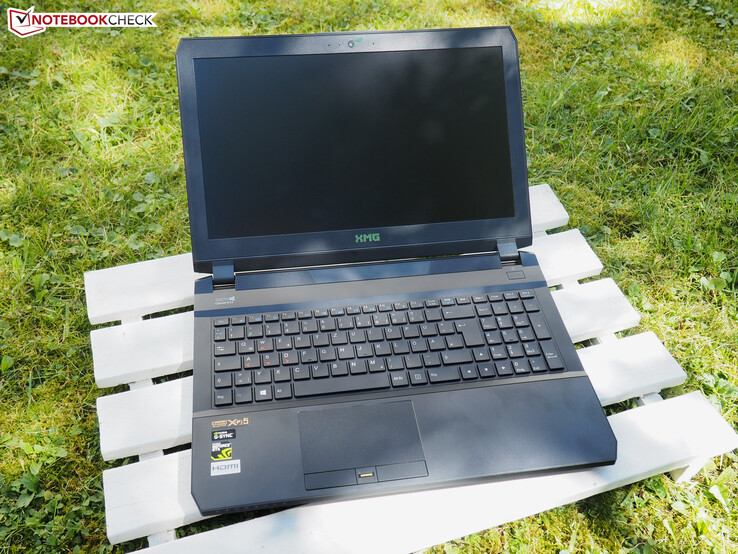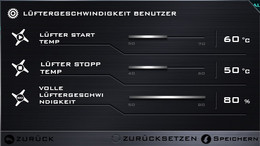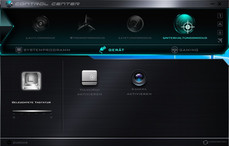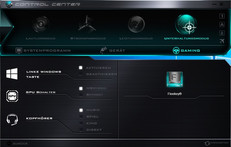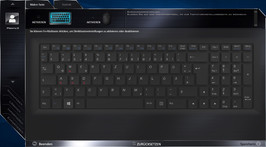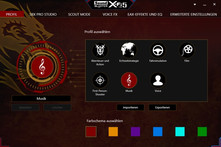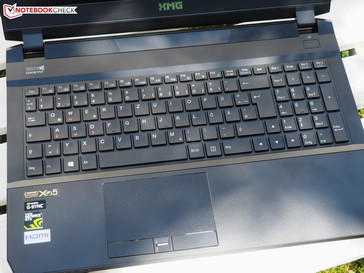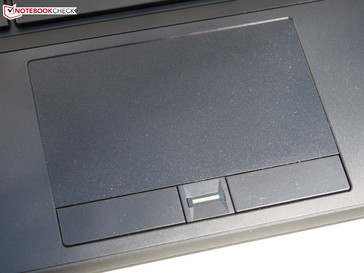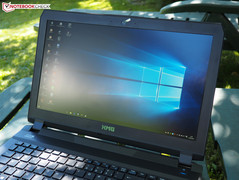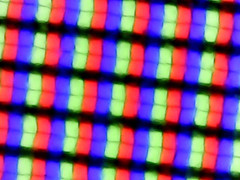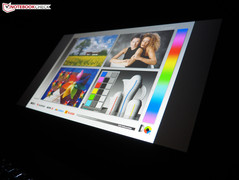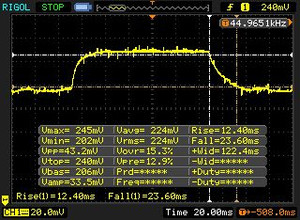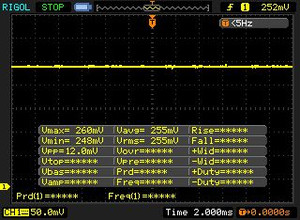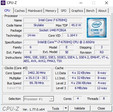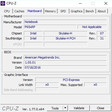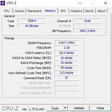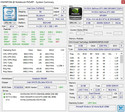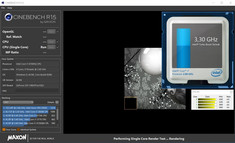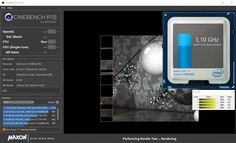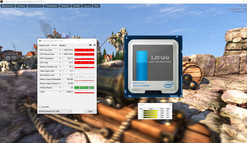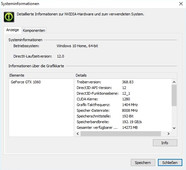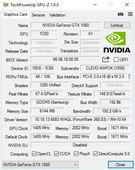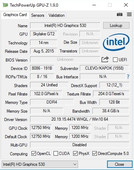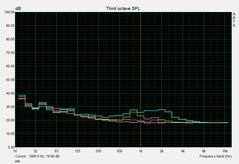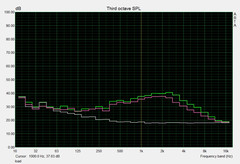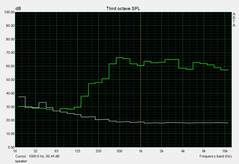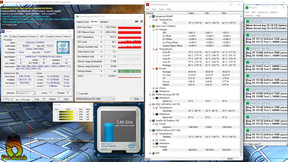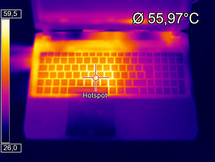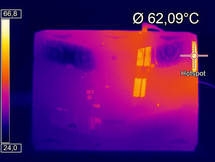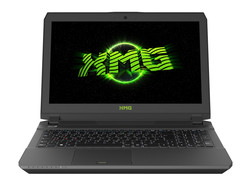Schenker XMG P507 (Clevo P651RP6-G) Notebook Review
For the original German review, see here.
While the most expensive gaming notebooks from Schenker Technologies are quite heavy and bulky (particularly the U series), the P series features a significantly slimmer and lighter chassis. Although our 15-inch XMG P507 test model is still below 3 cm (~1.2 in), buyers do not have to accept a much lower performance. On the one hand, it features a quad core processor from Intel (i7-6700HQ) and on the other, it has a gaming GPU from Nvidia's Pascal generation on board. Schenker has incorporated a GTX 1070 instead of a GTX 1060 for an extra 400 Euros (~$447).
In terms of RAM capacity, there are even more options, which range from 8 to a maximum of 64 GB (four DDR4 RAM slots). Likewise, you can choose from a plethora of storage solutions. There are even two 2.5-inch bays and two m.2 slots of the type 2280 under the hood. One of the latter supports PCIe/NVMe for particularly fast SSDs. In addition, customers are given options in terms of the Wi-Fi adapter, the keyboard variant, and the operating system. In any case the system comes with a matte IPS display with G-Sync support and 1920x1080 pixels.
The starting price for XMG P507 is 1599 Euros (~$1789). However, this configuration is quite sparse (no SSD, no OS and only an 8 GB single-channel RAM). Currently, our test model costs 1935 Euros (~$2165), which is not particularly affordable when compared with the competition. Speaking of the competition: Various high-end gamers want to compete with the XMG P507 in the 15-inch segment, for example the Asus GL502VS or the MSI GT62VR 6RE (both GTX 1070).
However, in this review we aim to focus on a few older devices in order to be able to better rate the performance gain of the new Pascal series - including its effects on temperature, system noise, and power consumption. Hence, we will also compare our test model with its direct predecessor XMG P506 (GTX 970M) as well as the Asus GL502VY (GTX 980M) and the Gigabyte P55K v5 (GTX 965M). Moreover, we have added notebooks with GeForce GTX 980 (e.g. the Schenker XMG U716) to our comparisons in the “Gaming Performance” section and thus, almost the entire high-end range is considered.
Case
The case has not changed much. Let us start with the most important fact: Depending on the selected graphics card, the 15-inch chassis is - just as its predecessors - either 2.5 or 2.9 cm high (~1 or 1.14 in). The slimmer variant with GTX 1060 is mostly made of metal (lid, underside, palm rests), which gives a very high-end impression.
The Barebone manufacturer Clevo, who had not in the past done such a good job in terms of design, has given the P651RP6-G chassis quite stylish lines without making the 15-inch device look too fussy. The laptop still looks discreet and lacks - unlike other high-end notebooks - excessive embellishment.
In our opinion, the compact build and the passable weight are the biggest highlights. With a weight of about 2.8 kg (~6.2 lb), the XMG P507 can still be easily carried around. Many 15-inch gaming laptops, for example the Acer Predator 15 or the Alienware 15 R2 exceed 3 kg (~6.6 lb). However, there are also slimmer and lighter rivals such as the MSI GS60 or the Gigabyte P35X v5, which, however, can quickly reach the limit of the cooling system.
Overall, we liked the chassis. You can hardly complain about the build quality and stability of the base unit. Only the lid could be significantly more rigid. In addition, twisting with two hands generates unpleasant noises, which reduces the quality impression somewhat.
The main problem of the Barebone is and will be the screen bleeding. Our new test model also showed lighter areas along the edges, which might not only be linked to the panel itself but also to the construction of the lid. Clevo should improve this - at the latest in the next generation. Some buyers might send the XMG P507 back for that very reason, since screen bleeding can be very annoying in practice (e.g. when watching videos). However, other manufacturers also struggle with this flaw. It is often a matter of luck whether and how intensively a display suffers from screen bleeding.
Connectivity
Interfaces
In terms of connectivity, the P651RP6-G Barebone cannot be criticized. Although the interface layout could be somewhat more convenient (most of the ports are on the right side), the number and variety are absolutely convincing. For example, the XMG P507 delivers three audio jacks, a SIM card slot and as many as five USB-ports, which is very respectable for a 15-inch device. Furthermore, two of the USB ports conform to the USB 3.1 Type-C standard (however, without Thunderbolt).
There are as many as three digital videos-outs in the form of HDMI 2.0 and 2x mini DisplayPort 1.3. Thanks to cutting-edge interfaces, a quad screen setup including notebook display and 4K output can be driven at 60 Hz. The ports that we have not mentioned as yet are depicted in the photos.
SD Card Reader
Apart from many supported formats (SD, Mini SD, SDHC, SDXC, MMC and RSMMC), the performance of the card reader is not outstanding. Just under 86 MB/s in sequential reading and 77 MB/s when moving many .JPG images are typical for a gaming notebook. The XMG P506 predecessor achieved very similar results with our reference card. The MSI GT62VR proves that a higher performance is possible with 190 and 140 MB/s, respectively, in this test.
| SD Card Reader | |
| average JPG Copy Test (av. of 3 runs) | |
| MSI GT62VR-6RE16H21 | |
| Schenker XMG P507 | |
| Schenker XMG P506 | |
| maximum AS SSD Seq Read Test (1GB) | |
| MSI GT62VR-6RE16H21 | |
| Schenker XMG P507 | |
| Schenker XMG P506 | |
Communication
A module from Intel provides wireless networking. The Wireless-AC 8260 costs only 10 Euros (~$11) more than the standard adapter Wireless-AC 3165. The main differences are the number of antennas (2x2 vs. 1x1) and the maximum transfer rate (867 vs. 433 MBit/s). In our router test, we measured an acceptable 456 MBit/s in sending and a good 642 MBit/s in receiving. The MSI GT62VR achieved 559 and 630 MBit/s, respectively. Schenker even sells a Wi-Fi model from Qualcomm Atheros (Killer Wireless-AC 1535) for 20 Euros (~$22).
| Networking | |
| iperf Server (receive) TCP 1 m | |
| Schenker XMG P507 | |
| MSI GT62VR-6RE16H21 | |
| iperf Client (transmit) TCP 1 m | |
| MSI GT62VR-6RE16H21 | |
| Schenker XMG P507 | |
Security
The XMG P507 does not neglect security. For example, a fingerprint sensor sits between the two touchpad buttons. A Kensington lock slot is on the right side and a TPM-2.0 chip completes the bundle.
Accessories
The scope of delivery is more than that of most notebook vendors. Apart from an XMG sticker (the chassis is already branded on the lid and the display frame) and a cleaning cloth, there are also a 16 GB USB thumb drive with drivers and several screws for the hard drive mounting brackets in the box. Anyone ordering an operating system will also get a system recovery DVD.
Maintenance
The maintenance of the XMG P507 is a mixed bag. On the one side, we regret that there is no “genuine” maintenance hatch and you have to remove the entire underside (which takes a long time due to the number of screws). On the other hand, you can upgrade many components and easily clean the device, once you have gained access to the inside. Regardless of whether Wi-Fi module, storage devices or RAM (two of four RAM slots are beneath the keyboard), you can reach all components with a little effort.
It is convenient that the cooling systems of CPU and GPU are separated. While the Core i7-6700HQ has two heatpipes and a fan, the GTX 1060 uses a total of three heatpipes and two fans. However, it is a pity that the battery is only accessible from inside. Unfortunately, this is becoming increasingly common in the notebook range.
Software
In terms of software, Schenker has focused on the essentials. This is good since too many tools and programs slow down booting and unnecessarily bloat Windows.
The Control Center in particular is noteworthy, since it does not only allow manual fan control, but also has an option called GPU switch. The latter can toggle between G-Sync and Nvidia's Optimus technology after rebooting for switching between the HD Graphics 530 in the processor and the GeForce GPU. We have run all our benchmarks and other measurements with active graphics switch. For example, the battery runtimes might be shorter without Optimus.
Warranty
As far as warranty is concerned, Schenker offers either 24 or 36 months Pickup & Return service. Optionally, the included 6-months quick repair can be expanded to the half or the whole warranty period.
Input Devices
Keyboard
We are already familiar with the input devices from the XMG P506. The Barebone expert Clevo has taken the keyboard to the new chassis without any modification. This also applies to the white, five-level light, which makes it easier to use the device in the dark. The quality of the keyboard is good. The edgy, matte-black keys are 15 x 15 mm (~0.6 x 0.6) on average and respond accurately to inputs. However, the strokes are rather loud due to the crisp mechanism. Other keyboards operate noticeably quieter.
The XMG P507 deserves praise for its dedicated number pad. The layout seems to be designed for gamers. For example, the arrow keys extend into the main part and the numeric keypad. However, Clevo has not been as eager as MSI to try out new things (see keyboard layout of the GT62VR). We would describe the position of the keyboard as normal. The palm rests are sufficiently large for a 15-inch device.
Touchpad
The size of the touchpad is also sufficient. With a length of 10.8 cm (~4.25 in) and a width of 6.2 cm (~2.44 in), it is comfortable to use. Thanks to a quite smooth surface, the fingers mostly glide easily over the mouse replacement. In addition, the precision does not need to hide behind the competition.
We were only slightly disappointed by the gesture support. Zooming and scrolling proved to be rather tricky in several situations. A special software for configuring gestures was not pre-installed on the test model. Clevo has lowered the touchpad slightly, so that it can be distinguished from the palm rests. The two buttons do a good job. They are neither spongy nor extremely loud.
Display
As we have already mentioned, the display has been taken directly from the predecessor. The LG Philips LP156WF6 (LGD046F) is a matte 15.6-inch model with IPS technology. It performs well in most categories. The contrast is high at 960:1 and most users might also be satisfied with the brightness (~290 cd/m²) and black value (0.3 cd/m²). As long as you do not use the display in direct sun, it even remains legible outdoors.
| |||||||||||||||||||||||||
Brightness Distribution: 87 %
Center on Battery: 288 cd/m²
Contrast: 960:1 (Black: 0.3 cd/m²)
ΔE ColorChecker Calman: 5.1 | ∀{0.5-29.43 Ø4.78}
ΔE Greyscale Calman: 4.43 | ∀{0.09-98 Ø5}
83% sRGB (Argyll 1.6.3 3D)
55% AdobeRGB 1998 (Argyll 1.6.3 3D)
61% AdobeRGB 1998 (Argyll 3D)
83.4% sRGB (Argyll 3D)
64.5% Display P3 (Argyll 3D)
Gamma: 2.46
CCT: 6687 K
| Schenker XMG P507 LG Philips LP156WF6 (LGD046F) | MSI GT62VR-6RE16H21 LG Philips LP156WF6 (LGD046F) | Asus Strix GL502VY-DS71 | Schenker XMG P506 PRO LG Philips LP156WF6 (LGD046F) | Gigabyte P55K v5 Name: AU Optronics B156HAN01.2, ID: AUO12ED | |
|---|---|---|---|---|---|
| Display | 1% | 0% | 0% | 6% | |
| Display P3 Coverage (%) | 64.5 | 64.6 0% | 63 -2% | 65.1 1% | 65.9 2% |
| sRGB Coverage (%) | 83.4 | 84.6 1% | 84.3 1% | 83.7 0% | 91 9% |
| AdobeRGB 1998 Coverage (%) | 61 | 61.8 1% | 61.6 1% | 61.2 0% | |
| Response Times | 5% | 0% | -6% | -15% | |
| Response Time Grey 50% / Grey 80% * (ms) | 36 ? | 34 ? 6% | 32 ? 11% | 37 ? -3% | 37.2 ? -3% |
| Response Time Black / White * (ms) | 23 ? | 22 ? 4% | 25.6 ? -11% | 25 ? -9% | 29.2 ? -27% |
| PWM Frequency (Hz) | |||||
| Screen | 9% | 5% | 6% | 2% | |
| Brightness middle (cd/m²) | 288 | 273 -5% | 347.2 21% | 312 8% | 274.9 -5% |
| Brightness (cd/m²) | 292 | 278 -5% | 327 12% | 293 0% | 259 -11% |
| Brightness Distribution (%) | 87 | 88 1% | 88 1% | 87 0% | 72 -17% |
| Black Level * (cd/m²) | 0.3 | 0.27 10% | 0.348 -16% | 0.32 -7% | 0.367 -22% |
| Contrast (:1) | 960 | 1011 5% | 998 4% | 975 2% | 749 -22% |
| Colorchecker dE 2000 * | 5.1 | 3.67 28% | 4.53 11% | 4.45 13% | 3.39 34% |
| Colorchecker dE 2000 max. * | 9.44 | 8.33 12% | 11.01 -17% | 8.5 10% | 5.76 39% |
| Greyscale dE 2000 * | 4.43 | 2.73 38% | 2.84 36% | 3.05 31% | 4.21 5% |
| Gamma | 2.46 89% | 2.49 88% | 2.05 107% | 2.58 85% | 2.18 101% |
| CCT | 6687 97% | 7029 92% | 6664 98% | 6495 100% | 6069 107% |
| Color Space (Percent of AdobeRGB 1998) (%) | 55 | 55 0% | 54.7 -1% | 55 0% | 59.2 8% |
| Color Space (Percent of sRGB) (%) | 83 | 84 1% | 84.1 1% | 84 1% | 90.9 10% |
| Total Average (Program / Settings) | 5% /
6% | 2% /
3% | 0% /
3% | -2% /
0% |
* ... smaller is better
Subjectively, games, videos, and images look quite intense and natural. However, the XMG P507 is not ideal for professional users who require a big gamut. With an sRGB coverage of 83% and an AdobeRGB coverage of 55%, the LG Philips LP156WF6’s performance is only average. However, hardly any gaming rival offers more. Among the comparison group only the Gigabyte P55K v5 stands out (91% sRGB, 59% AdobeRGB). Tip: The 4K display AU Optronics B173ZAN01.0, which is used in the XMG U716/726 and Acer Predator 17 among others, accomplishes 100% sRGB and 88% AdobeRGB.
The viewing angles of the XMG P507 are on the typical IPS level. Changes occur only at very flat angles, which you will actually never come across in everyday use; if at all.
Display Response Times
| ↔ Response Time Black to White | ||
|---|---|---|
| 23 ms ... rise ↗ and fall ↘ combined | ↗ 5 ms rise | |
| ↘ 18 ms fall | ||
| The screen shows good response rates in our tests, but may be too slow for competitive gamers. In comparison, all tested devices range from 0.1 (minimum) to 240 (maximum) ms. » 51 % of all devices are better. This means that the measured response time is worse than the average of all tested devices (20.2 ms). | ||
| ↔ Response Time 50% Grey to 80% Grey | ||
| 36 ms ... rise ↗ and fall ↘ combined | ↗ 12 ms rise | |
| ↘ 24 ms fall | ||
| The screen shows slow response rates in our tests and will be unsatisfactory for gamers. In comparison, all tested devices range from 0.165 (minimum) to 636 (maximum) ms. » 49 % of all devices are better. This means that the measured response time is worse than the average of all tested devices (31.6 ms). | ||
Screen Flickering / PWM (Pulse-Width Modulation)
| Screen flickering / PWM not detected | |||
In comparison: 53 % of all tested devices do not use PWM to dim the display. If PWM was detected, an average of 8108 (minimum: 5 - maximum: 343500) Hz was measured. | |||
Performance
Just as the previous XMG P506, the successor also aims at the high-end range. Apart from the mandatory components (Core i7-6700HQ, FHD panel), our test model comes with a 16 GB DDR4 RAM in dual channel mode and a combination from m.2-SSD and 2.5-inch HDD. The biggest highlight is Nvidia's brand new Pascal GPU, which is processed in 16 nm lithography (Maxwell: 28 nm) and hopefully brings sufficient VRAM for the coming years.
Processor
Intel's Core i7-6700HQ is the absolute classic among notebook CPUs. The quad core model is based on the current Skylake architecture and sports 6 MB L3 cache and a clock rate from 2.6 to 3.5 GHz.
The manufacturer specifies a TDP of 45 watts, which means that its cooling requirements are the same as its more expensive Core i7-6820HK sibling with 8 MB L3 cache and a clock rate from 2.7 to 3.6 GHz. Thanks to Hyperthreading, the two 14 nm models are capable of handling eight parallel threads.
As for clock behavior, there are no bad surprises: A short test with Cinebench R15 shows that the Core i7-6700HQ almost always runs close at its maximum Turbo. Depending on the number of cores used, the clock rate is between 3.1 and 3.5 GHz in the XMG P507. The competition shows a similar behavior. As a result all notebooks of the comparison group are on par in the CPU tests.
| Cinebench R15 | |
| CPU Single 64Bit | |
| Schenker XMG P507 | |
| Schenker XMG P506 | |
| Asus Strix GL502VY-DS71 | |
| MSI GT62VR-6RE16H21 | |
| Gigabyte P55K v5 | |
| CPU Multi 64Bit | |
| Schenker XMG P507 | |
| Schenker XMG P506 | |
| Gigabyte P55K v5 | |
| Asus Strix GL502VY-DS71 | |
| MSI GT62VR-6RE16H21 | |
| Cinebench R11.5 | |
| CPU Single 64Bit | |
| Schenker XMG P506 | |
| Asus Strix GL502VY-DS71 | |
| MSI GT62VR-6RE16H21 | |
| Schenker XMG P507 | |
| Gigabyte P55K v5 | |
| CPU Multi 64Bit | |
| Schenker XMG P506 | |
| Gigabyte P55K v5 | |
| Asus Strix GL502VY-DS71 | |
| Schenker XMG P507 | |
| MSI GT62VR-6RE16H21 | |
System Performance
As expected, the system performance is high. Thanks to a Solid-State Drive, the XMG P507 boots quickly and responses directly when opening programs. The time needed for loading games is also reasonably short. PCMark 7 confirms our subjective impression. With 6138 points, the test model can surpass MSI's GT62VR 6RE by 4%, which achieved 5926 points.
| PCMark 7 Score | 6138 points | |
Help | ||
| PCMark 7 - Score | |
| Schenker XMG P506 | |
| Schenker XMG P507 | |
| MSI GT62VR-6RE16H21 | |
Storage Devices
Although a standard SATA III SSD, which limits at about 500 MB/s, is sufficient for most users, the future belongs to PCIe Solid-State Drives. The 256 GB variant of the Samsung SM951 used in our test model performs excellently. About 2000 MB/s in sequential reading and 1200 MB/s in sequential writing (AS SSD Benchmark) deserve great respect and make rivals with standard SSDs look like a fool on paper. For example, our test models of the MSI GT62VR, the Asus GL502VY and the Gigabyte P55K v5 fall behind by over 60%.
The NVMe model is accompanied by a conventional hard drive in 2.5-inch format. The Terabyte Drive Western Digital Blue is quite fast for an HDD - despite a rotation speed of 5400 instead of 7200 RPM. CrystalDiskMark calculated a sequential rate of just under 120 MB/s. In short: Buyers cannot go wrong with this storage device combination and will get a responsive operating system as well as sufficient storage space for their videos, serials and game libraries.
| Schenker XMG P507 Samsung SM951 MZVPV256HDGL m.2 PCI-e | MSI GT62VR-6RE16H21 Toshiba HG6 THNSNJ256G8NY | Asus Strix GL502VY-DS71 SanDisk SD8SN8U1T001122 | Schenker XMG P506 Samsung SM951 MZHPV256HDGL m.2 PCI-e | Gigabyte P55K v5 SanDisk SD8SN8U1T001122 | |
|---|---|---|---|---|---|
| AS SSD | -60% | -67% | -18% | -66% | |
| Seq Read (MB/s) | 1983 | 502 -75% | 506 -74% | 1870 -6% | 467.6 -76% |
| Seq Write (MB/s) | 1200 | 455.5 -62% | 300.1 -75% | 1200 0% | 360.4 -70% |
| 4K Read (MB/s) | 50 | 20.08 -60% | 24.36 -51% | 39.23 -22% | 25.09 -50% |
| 4K Write (MB/s) | 144.1 | 89.9 -38% | 42.43 -71% | 93.9 -35% | 46.73 -68% |
| Score Total (Points) | 2566 | 915 -64% | 879 -66% | 1875 -27% | 868 -66% |
Graphics Card
Although notebooks with GeForce GTX 1060 are not particularly cheap, the DirectX 12 model is still the high-end model of the new Pascal generation with the most appealing price. However, the GTX 1060 has a significantly weaker hardware compared to the GTX 1070 and the GTX 1080. The most significant difference is the shader count. While the GTX 1080 uses 2560 and the GTX 1070 features 2048, the GTX 1060 comes with only 1280 CUDA cores, i.e. about half as much.
Another limitation is the memory interface. Although a 6 GB GDDR5 VRAM is quite generous and future-proof, it is only connected via a 192-bit bus. As the desktop version of the GTX 1060 has proven in our review, the small interface (for a high-end GPU) hardly has a negative effect, since Nvidia has tinkered on memory compression.
Meanwhile, the clock rates remind us of the GTX 1070. The core clocks at 1405 to 1671 MHz, while the GDDR5 VRAM reaches an effective clock rate of 8000 MHz. Top: Nvidia has so much confidence in its Pascal architecture that the chip clock can climb even higher in practice. According to the render test of the GPU-Z tool, the GTX 1060 achieves a maximum of 1911 MHz. However, the core settles at about 1570 MHz after 2 Unigine Heaven 4.0 runs, which is within the normal Turbo range.
In case you are wondering why the desktop model performs better: Thanks to the more powerful cooling and bigger space, the GTX 1060 had a more scope in our tower PC. On average, it clocks at 1820 MHz in the desktop computer (+16%). Hence, different Turbo usage and correspondingly deviating performance are possible in notebooks depending on the cooling capacity and the cooling reserves.
| 3DMark Vantage P Result | 34361 points | |
| 3DMark 11 Performance | 12349 points | |
| 3DMark Ice Storm Standard Score | 119721 points | |
| 3DMark Cloud Gate Standard Score | 22874 points | |
| 3DMark Fire Strike Score | 9331 points | |
| 3DMark Time Spy Score | 3588 points | |
Help | ||
Let us turn to the most important question: How fast is the GTX 1060 actually? The Fire Strike test of the current 3DMark gives us a first answer. With a GPU score of 11045 points, the 16 nm chip outdoes almost the entire Maxwell family. It performs +15% better than the GTX 980M and +45% better than the GTX 970M. Compared to a GTX 965M, it is even twice as fast. The GTX 1070 performs even better with 17066 points (+55%).
| 3DMark | |
| 1920x1080 Fire Strike Graphics | |
| MSI GT62VR-6RE16H21 | |
| Nvidia GeForce GTX 1060 Founders Edition 6 GB | |
| Schenker XMG P507 | |
| Asus Strix GL502VY-DS71 | |
| Schenker XMG P506 | |
| Gigabyte P55K v5 | |
| 2560x1440 Time Spy Graphics | |
| MSI GT62VR-6RE16H21 | |
| Schenker XMG P507 | |
| 3DMark 11 - 1280x720 Performance GPU | |
| MSI GT62VR-6RE16H21 | |
| Nvidia GeForce GTX 1060 Founders Edition 6 GB | |
| Schenker XMG P507 | |
| Asus Strix GL502VY-DS71 | |
| Schenker XMG P506 | |
| Gigabyte P55K v5 | |
| Unigine Heaven 4.0 - Extreme Preset DX11 | |
| MSI GT62VR-6RE16H21 | |
| Nvidia GeForce GTX 1060 Founders Edition 6 GB | |
| Schenker XMG P507 | |
Gaming Performance
The gaming performance of the GTX 1060 highly depends on the selected resolution. UHD displays with 3840x2160 pixels can quickly overwhelm the newcomer; at least with high details. “The Witcher 3”, “Assassin's Creed Syndicate”, “XCOM 2”, “Far Cry Primal”, “The Division”, “Hitman” and “Mirrors Edge Catalyst” are not playable in 4K (less than 25 fps). “Batman Arkham Knight”, “Call of Duty Black Ops 3”, “Fallout 4”, and “Rise of The Tomb Raider” also do not run smoothly.
| Graphics Card | Total performance (4K/High & FHD/Ultra) |
|---|---|
| GeForce GTX 1070 Notebook | +36 % |
| GeForce GTX 980 Notebook | +19 % |
| GeForce GTX 1060 Desktop | +15 % |
| GeForce GTX 1060 Notebook | Basis |
| GeForce GTX 980M | -19 % |
| GeForce GTX 970M | -35 % |
The GTX 1060 is much more comfortable with Full HD. Maximum details and multiple anti-aliasing is usually not an issue here. Only Anno 2205 and XCOM 2 remained under 30 fps with 1920x1080 pixels. Overall, the GTX 1060 performs relatively well, without being able to keep up with the GTX 1070 and GTX 1080 top models. The latter is significantly more suitable for fans of high-resolution displays.
| Mirror's Edge Catalyst | |
| 3840x2160 High Preset AF:16x | |
| MSI GT62VR-6RE16H21 | |
| Asus GX800 Prototype | |
| Nvidia GeForce GTX 1060 Founders Edition 6 GB | |
| Schenker XMG P507 | |
| Schenker W504 | |
| Schenker W504 | |
| 1920x1080 Ultra Preset AF:16x | |
| MSI GT62VR-6RE16H21 | |
| Asus GX800 Prototype | |
| Nvidia GeForce GTX 1060 Founders Edition 6 GB | |
| Schenker XMG P507 | |
| Schenker W504 | |
| Schenker W504 | |
| Overwatch | |
| 3840x2160 High (Render Scale 100 %) AA:SM AF:4x | |
| MSI GT62VR-6RE16H21 | |
| Asus GX800 Prototype | |
| Nvidia GeForce GTX 1060 Founders Edition 6 GB | |
| Schenker XMG P507 | |
| Schenker W504 | |
| Schenker W504 | |
| 1920x1080 Epic (Render Scale 100 %) AA:SM AF:16x | |
| MSI GT62VR-6RE16H21 | |
| Asus GX800 Prototype | |
| Nvidia GeForce GTX 1060 Founders Edition 6 GB | |
| Schenker XMG P507 | |
| Schenker W504 | |
| Schenker W504 | |
| Doom | |
| 3840x2160 High Preset AA:FX | |
| MSI GT62VR-6RE16H21 | |
| Asus GX800 Prototype | |
| Nvidia GeForce GTX 1060 Founders Edition 6 GB | |
| Schenker XMG P507 | |
| Schenker W504 | |
| Schenker W504 | |
| 1920x1080 Ultra Preset AA:SM | |
| MSI GT62VR-6RE16H21 | |
| Asus GX800 Prototype | |
| Nvidia GeForce GTX 1060 Founders Edition 6 GB | |
| Schenker XMG P507 | |
| Schenker W504 | |
| Schenker W504 | |
| Need for Speed 2016 | |
| 3840x2160 High / On AA:FX | |
| MSI GT62VR-6RE16H21 | |
| Asus GX800 Prototype | |
| Nvidia GeForce GTX 1060 Founders Edition 6 GB | |
| Schenker XMG P507 | |
| Schenker W504 | |
| Schenker W504 | |
| 1920x1080 Ultra / On AA:T | |
| Nvidia GeForce GTX 1060 Founders Edition 6 GB | |
| Asus GX800 Prototype | |
| MSI GT62VR-6RE16H21 | |
| Schenker XMG P507 | |
| Schenker W504 | |
| Schenker W504 | |
| Hitman 2016 | |
| 3840x2160 High / On AA:FX AF:8x | |
| MSI GT62VR-6RE16H21 | |
| Asus GX800 Prototype | |
| Nvidia GeForce GTX 1060 Founders Edition 6 GB | |
| Nvidia GeForce GTX 1060 Founders Edition 6 GB | |
| Schenker XMG P507 | |
| Schenker W504 | |
| Schenker W504 | |
| 1920x1080 Ultra / On AA:SM AF:16x | |
| Asus GX800 Prototype | |
| MSI GT62VR-6RE16H21 | |
| Nvidia GeForce GTX 1060 Founders Edition 6 GB | |
| Nvidia GeForce GTX 1060 Founders Edition 6 GB | |
| Schenker XMG P507 | |
| Schenker W504 | |
| Schenker W504 | |
| The Division | |
| 3840x2160 High Preset AF:8x | |
| MSI GT62VR-6RE16H21 | |
| Asus GX800 Prototype | |
| Nvidia GeForce GTX 1060 Founders Edition 6 GB | |
| Schenker XMG P507 | |
| 1920x1080 Ultra Preset AF:16x | |
| MSI GT62VR-6RE16H21 | |
| Asus GX800 Prototype | |
| Nvidia GeForce GTX 1060 Founders Edition 6 GB | |
| Schenker XMG P507 | |
| Schenker W504 | |
| Schenker W504 | |
| Far Cry Primal | |
| 3840x2160 High Preset AA:SM | |
| MSI GT62VR-6RE16H21 | |
| Asus GX800 Prototype | |
| Nvidia GeForce GTX 1060 Founders Edition 6 GB | |
| Schenker XMG P507 | |
| Schenker W504 | |
| Schenker W504 | |
| 1920x1080 Ultra Preset AA:SM | |
| MSI GT62VR-6RE16H21 | |
| Asus GX800 Prototype | |
| Nvidia GeForce GTX 1060 Founders Edition 6 GB | |
| Schenker XMG P507 | |
| Schenker W504 | |
| Schenker W504 | |
| XCOM 2 | |
| 3840x2160 High Preset AA:FX AF:8x | |
| MSI GT62VR-6RE16H21 | |
| Asus GX800 Prototype | |
| Nvidia GeForce GTX 1060 Founders Edition 6 GB | |
| Schenker XMG P507 | |
| 1920x1080 Maximum Preset (8xMSAA instead of FXAA) AA:8xMS AF:16x | |
| MSI GT62VR-6RE16H21 | |
| Asus GX800 Prototype | |
| Nvidia GeForce GTX 1060 Founders Edition 6 GB | |
| Schenker XMG P507 | |
| Schenker W504 | |
| Schenker W504 | |
| Rise of the Tomb Raider | |
| 3840x2160 High Preset AA:FX AF:4x | |
| MSI GT62VR-6RE16H21 | |
| Asus GX800 Prototype | |
| Nvidia GeForce GTX 1060 Founders Edition 6 GB | |
| Nvidia GeForce GTX 1060 Founders Edition 6 GB | |
| Schenker XMG P507 | |
| Schenker W504 | |
| Schenker W504 | |
| 1920x1080 Very High Preset AA:FX AF:16x | |
| MSI GT62VR-6RE16H21 | |
| Asus GX800 Prototype | |
| Nvidia GeForce GTX 1060 Founders Edition 6 GB | |
| Nvidia GeForce GTX 1060 Founders Edition 6 GB | |
| Schenker XMG P507 | |
| Schenker W504 | |
| Schenker W504 | |
| Just Cause 3 | |
| 3840x2160 High / On AA:FX AF:8x | |
| Nvidia GeForce GTX 1060 Founders Edition 6 GB | |
| Schenker XMG P507 | |
| Schenker W504 | |
| Schenker W504 | |
| 1920x1080 Very High / On AA:SM AF:16x | |
| MSI GT62VR-6RE16H21 | |
| Nvidia GeForce GTX 1060 Founders Edition 6 GB | |
| Schenker XMG P507 | |
| Schenker W504 | |
| Schenker W504 | |
| Rainbow Six Siege | |
| 3840x2160 High Preset AA:T AF:4x | |
| MSI GT62VR-6RE16H21 | |
| Nvidia GeForce GTX 1060 Founders Edition 6 GB | |
| Schenker XMG P507 | |
| Schenker W504 | |
| Schenker W504 | |
| 1920x1080 Ultra Preset AA:T AF:16x | |
| MSI GT62VR-6RE16H21 | |
| Nvidia GeForce GTX 1060 Founders Edition 6 GB | |
| Schenker XMG P507 | |
| Schenker W504 | |
| Schenker W504 | |
| Assassin's Creed Syndicate | |
| 3840x2160 High Preset AA:FX | |
| MSI GT62VR-6RE16H21 | |
| Schenker XMG U716 | |
| Nvidia GeForce GTX 1060 Founders Edition 6 GB | |
| Schenker XMG P507 | |
| Schenker W504 | |
| Schenker W504 | |
| 1920x1080 Ultra High Preset AA:4x MSAA + FX | |
| MSI GT62VR-6RE16H21 | |
| Nvidia GeForce GTX 1060 Founders Edition 6 GB | |
| Schenker XMG U716 | |
| Schenker XMG P507 | |
| Schenker W504 | |
| Schenker W504 | |
| Star Wars Battlefront | |
| 3840x2160 High Preset AA:FX | |
| MSI GT62VR-6RE16H21 | |
| Schenker XMG U716 | |
| Nvidia GeForce GTX 1060 Founders Edition 6 GB | |
| Schenker XMG P507 | |
| Schenker W504 | |
| Schenker W504 | |
| 1920x1080 Ultra Preset AA:FX | |
| MSI GT62VR-6RE16H21 | |
| Schenker XMG U716 | |
| Nvidia GeForce GTX 1060 Founders Edition 6 GB | |
| Schenker XMG P507 | |
| Schenker W504 | |
| Schenker W504 | |
| Fallout 4 | |
| 3840x2160 High Preset AA:T AF:16x | |
| MSI GT62VR-6RE16H21 | |
| Schenker XMG U716 | |
| Nvidia GeForce GTX 1060 Founders Edition 6 GB | |
| Schenker XMG P507 | |
| Schenker W504 | |
| Schenker W504 | |
| 1920x1080 Ultra Preset AA:T AF:16x | |
| MSI GT62VR-6RE16H21 | |
| Schenker XMG U716 | |
| Nvidia GeForce GTX 1060 Founders Edition 6 GB | |
| Schenker XMG P507 | |
| Schenker W504 | |
| Schenker W504 | |
| Call of Duty: Black Ops 3 | |
| 3840x2160 High / On AA:FX | |
| MSI GT62VR-6RE16H21 | |
| Schenker XMG U716 | |
| Nvidia GeForce GTX 1060 Founders Edition 6 GB | |
| Schenker XMG P507 | |
| Schenker W504 | |
| Schenker W504 | |
| 1920x1080 Extra / On AA:T2x SM | |
| MSI GT62VR-6RE16H21 | |
| Schenker XMG U716 | |
| Nvidia GeForce GTX 1060 Founders Edition 6 GB | |
| Schenker XMG P507 | |
| Schenker W504 | |
| Schenker W504 | |
| Anno 2205 | |
| 3840x2160 High Preset AA:4x | |
| MSI GT62VR-6RE16H21 | |
| Nvidia GeForce GTX 1060 Founders Edition 6 GB | |
| Schenker XMG U716 | |
| Schenker XMG P507 | |
| Schenker W504 | |
| Schenker W504 | |
| 1920x1080 Ultra High Preset AA:8x | |
| MSI GT62VR-6RE16H21 | |
| Nvidia GeForce GTX 1060 Founders Edition 6 GB | |
| Schenker XMG U716 | |
| Schenker XMG P507 | |
| Schenker W504 | |
| Schenker W504 | |
| FIFA 16 | |
| 3840x2160 High Preset AA:2x MS | |
| MSI GT62VR-6RE16H21 | |
| Nvidia GeForce GTX 1060 Founders Edition 6 GB | |
| Schenker XMG U716 | |
| Schenker XMG P507 | |
| Schenker W504 | |
| Schenker W504 | |
| 1920x1080 High Preset AA:4x MS | |
| Nvidia GeForce GTX 1060 Founders Edition 6 GB | |
| Schenker XMG U716 | |
| Schenker XMG P507 | |
| MSI GT62VR-6RE16H21 | |
| Schenker W504 | |
| Schenker W504 | |
| Mad Max | |
| 3840x2160 High Preset AF:6x | |
| Schenker XMG U716 | |
| Nvidia GeForce GTX 1060 Founders Edition 6 GB | |
| Schenker XMG P507 | |
| Schenker W504 | |
| Schenker W504 | |
| 1920x1080 Very High Preset AF:12x | |
| MSI GT62VR-6RE16H21 | |
| Schenker XMG U716 | |
| Nvidia GeForce GTX 1060 Founders Edition 6 GB | |
| Schenker XMG P507 | |
| Schenker W504 | |
| Schenker W504 | |
| Batman: Arkham Knight | |
| 3840x2160 High / On (Interactive Smoke & Paper Debris Off) AA:SM AF:8x | |
| MSI GT62VR-6RE16H21 | |
| Schenker XMG U716 | |
| Nvidia GeForce GTX 1060 Founders Edition 6 GB | |
| Schenker XMG P507 | |
| Schenker W504 | |
| Schenker W504 | |
| 1920x1080 High / On AA:SM AF:16x | |
| MSI GT62VR-6RE16H21 | |
| Schenker XMG U716 | |
| Nvidia GeForce GTX 1060 Founders Edition 6 GB | |
| Schenker XMG P507 | |
| Schenker W504 | |
| Schenker W504 | |
| The Witcher 3 | |
| 3840x2160 High Graphics & Postprocessing (Nvidia HairWorks Off) | |
| MSI GT62VR-6RE16H21 | |
| Schenker XMG U716 | |
| Nvidia GeForce GTX 1060 Founders Edition 6 GB | |
| Schenker XMG P507 | |
| Schenker W504 | |
| Schenker W504 | |
| 1920x1080 Ultra Graphics & Postprocessing (HBAO+) | |
| MSI GT62VR-6RE16H21 | |
| Nvidia GeForce GTX 1060 Founders Edition 6 GB | |
| Schenker XMG U716 | |
| Schenker XMG P507 | |
| Schenker W504 | |
| Schenker W504 | |
| Dirt Rally | |
| 3840x2160 High Preset | |
| Nvidia GeForce GTX 1060 Founders Edition 6 GB | |
| Schenker XMG U716 | |
| Schenker XMG P507 | |
| Schenker W504 | |
| Schenker W504 | |
| 1920x1080 Ultra Preset AA:4x MS | |
| Nvidia GeForce GTX 1060 Founders Edition 6 GB | |
| Schenker XMG U716 | |
| Schenker XMG P507 | |
| MSI GT62VR-6RE16H21 | |
| Schenker W504 | |
| Schenker W504 | |
| Dragon Age: Inquisition - 1920x1080 Ultra Graphics Quality AA:2x MS | |
| MSI GT62VR-6RE16H21 | |
| Nvidia GeForce GTX 1060 Founders Edition 6 GB | |
| Schenker XMG U716 | |
| Schenker XMG P507 | |
| One K73-5N | |
| Alien: Isolation - 1920x1080 Ultra, On, Shadow Map 2048, HDAO AA:2x SM AF:16x | |
| MSI GT62VR-6RE16H21 | |
| Schenker XMG U716 | |
| Nvidia GeForce GTX 1060 Founders Edition 6 GB | |
| Schenker XMG P507 | |
| One K73-5N | |
| Schenker XMG P505 | |
| Sims 4 - 1920x1080 Ultra Preset | |
| Nvidia GeForce GTX 1060 Founders Edition 6 GB | |
| Schenker XMG P507 | |
| Schenker XMG U716 | |
| One K73-5N | |
| MSI GT62VR-6RE16H21 | |
| Schenker XMG P505 | |
| GRID: Autosport - 1920x1080 Ultra Preset AA:4x MS | |
| Nvidia GeForce GTX 1060 Founders Edition 6 GB | |
| Schenker XMG U716 | |
| Schenker XMG P507 | |
| MSI GT62VR-6RE16H21 | |
| Schenker XMG P505 | |
| Watch Dogs - 1920x1080 Ultra Overall Quality, Ultra Textures AA:4x MS | |
| Nvidia GeForce GTX 1060 Founders Edition 6 GB | |
| Schenker XMG U716 | |
| MSI GT62VR-6RE16H21 | |
| Schenker XMG P507 | |
| One K73-5N | |
| Schenker XMG P505 | |
| Thief - 1920x1080 Very High Preset AA:FXAA & High SS AF:8x | |
| Schenker XMG U716 | |
| MSI GT62VR-6RE16H21 | |
| Schenker XMG P507 | |
| Schenker XMG P505 | |
| Battlefield 4 | |
| 3840x2160 High Preset | |
| MSI GT62VR-6RE16H21 | |
| Schenker XMG U716 | |
| Schenker XMG P507 | |
| Schenker W504 | |
| Schenker W504 | |
| 1920x1080 Ultra Preset AA:4x MS | |
| MSI GT62VR-6RE16H21 | |
| Schenker XMG U716 | |
| Schenker XMG P507 | |
| Schenker XMG P505 | |
| Metro: Last Light - 1920x1080 Very High (DX11) AF:16x | |
| MSI GT62VR-6RE16H21 | |
| Schenker XMG U716 | |
| Schenker XMG P507 | |
| Schenker XMG P505 | |
| BioShock Infinite - 1920x1080 Ultra Preset, DX11 (DDOF) | |
| MSI GT62VR-6RE16H21 | |
| Schenker XMG U716 | |
| Schenker XMG P507 | |
| Schenker XMG P505 | |
| Crysis 3 - 1920x1080 Very High Preset AA:2xSM AF:16x | |
| MSI GT62VR-6RE16H21 | |
| Schenker XMG U716 | |
| Schenker XMG P507 | |
| Schenker XMG P505 | |
In our opinion, Nvidia should announce a GTX 1065 as soon as possible in order to close the “performance gap”. The performance gain from GTX 960M to GTX 970M was also very big, which was fixed by the GTX 965M. But back to the topic: Compared to the 28 nm chips of the Maxwell series, the GTX 1060 is very powerful. If you consider all FHD/Ultra and 4K/high benchmarks, the Pascal model ranks in between GTX 980M and the previous GTX 980 top model.
| low | med. | high | ultra | 4K | |
|---|---|---|---|---|---|
| Crysis 3 (2013) | 51.7 | ||||
| BioShock Infinite (2013) | 98.1 | ||||
| Metro: Last Light (2013) | 73.8 | ||||
| Battlefield 4 (2013) | 92.9 | 45.4 | |||
| Thief (2014) | 71.4 | ||||
| Watch Dogs (2014) | 70.4 | 54.4 | |||
| GRID: Autosport (2014) | 141 | 120 | |||
| Sims 4 (2014) | 122 | 119 | |||
| Alien: Isolation (2014) | 163 | 115 | |||
| Dragon Age: Inquisition (2014) | 90 | 59.7 | |||
| Dirt Rally (2015) | 122 | 95.6 | 79 | ||
| The Witcher 3 (2015) | 67.1 | 37.7 | 24.9 | ||
| Batman: Arkham Knight (2015) | 83 | 57 | 28 | ||
| Mad Max (2015) | 124 | 114 | 41.3 | ||
| FIFA 16 (2015) | 241 | 111 | |||
| Anno 2205 (2015) | 81.1 | 28.6 | 32.4 | ||
| Call of Duty: Black Ops 3 (2015) | 80.6 | 73.2 | 26.6 | ||
| Fallout 4 (2015) | 80.1 | 64.2 | 28.8 | ||
| Star Wars Battlefront (2015) | 102 | 88.4 | 33.4 | ||
| Assassin's Creed Syndicate (2015) | 69.9 | 30.8 | 24.4 | ||
| Rainbow Six Siege (2015) | 136 | 115 | 42.7 | ||
| Just Cause 3 (2015) | 81.8 | 71 | 30.3 | ||
| Rise of the Tomb Raider (2016) | 67.7 | 59.1 | 25.4 | ||
| XCOM 2 (2016) | 56.1 | 29.1 | 16.3 | ||
| Far Cry Primal (2016) | 76 | 56 | 24 | ||
| The Division (2016) | 64 | 50.4 | 24.2 | ||
| Hitman 2016 (2016) | 52.2 | 49.6 | 23 | ||
| Need for Speed 2016 (2016) | 87.8 | 65 | 31.4 | ||
| Doom (2016) | 98 | 91.5 | 31.5 | ||
| Overwatch (2016) | 169 | 103 | 54.8 | ||
| Mirror's Edge Catalyst (2016) | 74.1 | 67.1 | 24.8 |
Emissions
System Noise
The system noise should be improved. An average of 46 dB(A) during 3DMark 06 and up to 49 dB(A) under full load is relatively high even for a gaming notebook. The predecessor got even louder during the stress test with a slightly higher 51 dB(A), but remained quieter during standard 3D use (42 dB). The GTX 1070 competitor MSI GT62VR also worked quieter under load (40 to 46 dB). The disadvantages of the just under 1.5 cm (~0.6 in) chassis are notably here.
The chassis manufacturer could also improve the idle behavior. While the base level of 31 to 32 dB(A) is very discreet and you can only hear a quiet rusting fan (the left one sometimes stands still), sometimes annoying noise peaks occur without any obvious reason. Quite undemanding tasks such as web browsing or installations sometimes force unnecessary changes in the fans' rotation speeds. This behavior is typical of Clevo Barebones, whereas it has already been improved in the past 1 to 2 years.
A short time after we performed our system noise measurements, Schenker sent us a new EC BIOS, which was supposed to make the fan control “smoother”. However, we were unable to install it, since the USB ports of the test model did not recognize any USB sticks and the Windows update also failed. To cut a long story short, the XMG P507 might show fewer peaks in system noise in the meantime. The running hard drive is louder than the fan when the system is idling. Ideally, omitting the HDD would give an almost silent noise level.
Noise level
| Idle |
| 31 / 32 / 38 dB(A) |
| HDD |
| 33 dB(A) |
| Load |
| 46 / 49 dB(A) |
 | ||
30 dB silent 40 dB(A) audible 50 dB(A) loud |
||
min: | ||
| Schenker XMG P507 GeForce GTX 1060 Mobile, 6700HQ | MSI GT62VR-6RE16H21 GeForce GTX 1070 Mobile, 6700HQ | Asus Strix GL502VY-DS71 GeForce GTX 980M, 6700HQ | Schenker XMG P506 GeForce GTX 970M, 6700HQ | Gigabyte P55K v5 GeForce GTX 965M, 6700HQ | |
|---|---|---|---|---|---|
| Noise | 4% | 2% | 2% | 3% | |
| off / environment * (dB) | 30 | 30 -0% | 29.4 2% | 29 3% | |
| Idle Minimum * (dB) | 31 | 32 -3% | 32 -3% | 30.8 1% | 32 -3% |
| Idle Average * (dB) | 32 | 33 -3% | 32.2 -1% | 32.8 -3% | 33 -3% |
| Idle Maximum * (dB) | 38 | 34 11% | 32.2 15% | 35.9 6% | 33 13% |
| Load Average * (dB) | 46 | 40 13% | 45.3 2% | 42.2 8% | 41 11% |
| Load Maximum * (dB) | 49 | 46 6% | 50.1 -2% | 51 -4% | 50 -2% |
* ... smaller is better
Temperature
The temperatures are acceptable in view of the high performance and the slim chassis. Often larger 15-inch notebooks also reach an average of 29 °C (~84 °F) when idling and 40 °C (~104 °F; top side) and 42 °C (~108 °F; underside) during the stress test. We measured a maximum of 53 °C (~127 °F) on the underside. Hence, you should avoid gaming on the lap. On the positive side, the palm rests never exceed 30 °C (~86 °F). The layout of the cooling system has primarily been designed for right-handed persons. Those using a mouse on the left side will suffer from the CPU waste heat. In contrast, the GPU fans are rear-facing.
The hardware has to sweat significantly more. However, the temperatures remained uncritical even after an hour of full load with the FurMark and Prime95 tools. Just under 80 °C (~176 °F) at the Core i7-6700HQ and about 70 °C (~158 °F) at the slightly throttling GTX 1060 (this is rather due to FurMark than to the cooling system), are alright, since the CPU Turbo is still slightly used. Conversely, the XMG P507 need not get as loud as it currently does.
(-) The maximum temperature on the upper side is 49.3 °C / 121 F, compared to the average of 40.4 °C / 105 F, ranging from 21.2 to 68.8 °C for the class Gaming.
(-) The bottom heats up to a maximum of 52.7 °C / 127 F, compared to the average of 43.3 °C / 110 F
(+) In idle usage, the average temperature for the upper side is 29.1 °C / 84 F, compared to the device average of 33.9 °C / 93 F.
(+) The palmrests and touchpad are cooler than skin temperature with a maximum of 29.6 °C / 85.3 F and are therefore cool to the touch.
(±) The average temperature of the palmrest area of similar devices was 28.9 °C / 84 F (-0.7 °C / -1.3 F).
| Schenker XMG P507 GeForce GTX 1060 Mobile, 6700HQ | MSI GT62VR-6RE16H21 GeForce GTX 1070 Mobile, 6700HQ | Asus Strix GL502VY-DS71 GeForce GTX 980M, 6700HQ | Schenker XMG P506 GeForce GTX 970M, 6700HQ | Gigabyte P55K v5 GeForce GTX 965M, 6700HQ | |
|---|---|---|---|---|---|
| Heat | 7% | -1% | -5% | 13% | |
| Maximum Upper Side * (°C) | 49.3 | 44 11% | 60.4 -23% | 49.3 -0% | 52.6 -7% |
| Maximum Bottom * (°C) | 52.7 | 53.1 -1% | 44 17% | 60.4 -15% | 50.2 5% |
| Idle Upper Side * (°C) | 32.6 | 28.8 12% | 31.2 4% | 31.4 4% | 22.6 31% |
| Idle Bottom * (°C) | 29.5 | 28.2 4% | 29.4 -0% | 32.3 -9% | 23.4 21% |
* ... smaller is better
Speakers
The sound system might be identical to that of the previous generation. Clevo has incorporated a 2.0 system from Onkyo, which is supported by the sound software Sound Blaster X-Fi MB5 (contains many profiles including video, music, and voice). The audio analysis, which we have introduced a short time ago, shows that the XMG P507 is about on par with the MSI GT62VR, whereas low tones and high tones should be improved. The lack of a subwoofer definitely delivers a weak and disappointing bass.
All things considered, the sound is (upper) mid-range. We recommend using external speakers or a headset in the long run, since the sound can be rather tinny and imprecise. However, it is difficult to generate a convincing sound experience in such a slim chassis. Other slim gaming laptops perform even worse in this category.
Schenker XMG P507 audio analysis
(±) | speaker loudness is average but good (75 dB)
Bass 100 - 315 Hz
(-) | nearly no bass - on average 20.7% lower than median
(±) | linearity of bass is average (8.8% delta to prev. frequency)
Mids 400 - 2000 Hz
(+) | balanced mids - only 2.2% away from median
(±) | linearity of mids is average (7.6% delta to prev. frequency)
Highs 2 - 16 kHz
(+) | balanced highs - only 2.3% away from median
(+) | highs are linear (5.3% delta to prev. frequency)
Overall 100 - 16.000 Hz
(±) | linearity of overall sound is average (19% difference to median)
Compared to same class
» 63% of all tested devices in this class were better, 8% similar, 29% worse
» The best had a delta of 6%, average was 18%, worst was 132%
Compared to all devices tested
» 44% of all tested devices were better, 8% similar, 48% worse
» The best had a delta of 4%, average was 24%, worst was 134%
MSI GT62VR-6RE16H21 audio analysis
(±) | speaker loudness is average but good (79 dB)
Bass 100 - 315 Hz
(±) | reduced bass - on average 11.3% lower than median
(±) | linearity of bass is average (11.4% delta to prev. frequency)
Mids 400 - 2000 Hz
(±) | higher mids - on average 8.3% higher than median
(+) | mids are linear (5.7% delta to prev. frequency)
Highs 2 - 16 kHz
(+) | balanced highs - only 4.3% away from median
(±) | linearity of highs is average (11% delta to prev. frequency)
Overall 100 - 16.000 Hz
(±) | linearity of overall sound is average (20.5% difference to median)
Compared to same class
» 73% of all tested devices in this class were better, 5% similar, 22% worse
» The best had a delta of 6%, average was 18%, worst was 132%
Compared to all devices tested
» 53% of all tested devices were better, 8% similar, 39% worse
» The best had a delta of 4%, average was 24%, worst was 134%
Frequenzdiagramm im Vergleich (Checkboxen oben an-/abwählbar!)
Wert 2: Pink Noise 100% Vol.; Wert 1: Audio aus
Energy Management
Power Consumption
Nvidia's Pascal architecture does not only stand out with high-end performance, but also with modest power consumption. This is particularly apparent when compared with the predecessor. Although the GeForce GTX 1060 is about 1.5 times as fast as the previous GTX 970M, the XMG P507 required just under 2 watts less than the XMG P506 in the first passage of 3DMark 06, even though the latter is also powered by a Core i7-6700HQ. Only the maximum power consumption is significantly higher in the XMG P507 with 174 vs. 146 watts. The idle results are similar again. Nvidia's Optimus technology ensures a fairly frugal consumption of 11 to 21 watts. MSI's GT62VR requires almost double the energy (no graphics switch).
| Off / Standby | |
| Idle | |
| Load |
|
Key:
min: | |
| Schenker XMG P507 GeForce GTX 1060 Mobile, 6700HQ | MSI GT62VR-6RE16H21 GeForce GTX 1070 Mobile, 6700HQ | Asus Strix GL502VY-DS71 GeForce GTX 980M, 6700HQ | Schenker XMG P506 GeForce GTX 970M, 6700HQ | Gigabyte P55K v5 GeForce GTX 965M, 6700HQ | |
|---|---|---|---|---|---|
| Power Consumption | -48% | -39% | 6% | 15% | |
| Idle Minimum * (Watt) | 11 | 20 -82% | 20.6 -87% | 10.5 5% | 10.1 8% |
| Idle Average * (Watt) | 16 | 26 -63% | 22.1 -38% | 14.6 9% | 13.3 17% |
| Idle Maximum * (Watt) | 21 | 32 -52% | 22.5 -7% | 20.7 1% | 15.4 27% |
| Load Average * (Watt) | 80 | 100 -25% | 130.6 -63% | 81.8 -2% | 75.8 5% |
| Load Maximum * (Watt) | 174 | 202 -16% | 177.2 -2% | 146.3 16% | 144 17% |
* ... smaller is better
Battery Life
Despite the slightly lower battery capacity (60 Wh), the combination of Optimus and energy-efficient CPU and GPU architecture ensures a decent battery life. About two hours at maximum brightness and high load are as good as just under 7 hours when running idle at minimum brightness. In our realistic Wi-Fi test, which automatically opens a number of web sites, the XMG P507 achieved just above 4.5 hours, which is also not bad in view of the limited space in the slim chassis. By the way, the frame rate of the GPU is limited to 30 fps on battery.
| Schenker XMG P507 60 Wh | MSI GT62VR-6RE16H21 75.24 Wh | Asus Strix GL502VY-DS71 64 Wh | Schenker XMG P506 60 Wh | Gigabyte P55K v5 63 Wh | |
|---|---|---|---|---|---|
| Battery runtime | -20% | -34% | -24% | -2% | |
| Reader / Idle (h) | 6.8 | 5 -26% | 4.6 -32% | 5.2 -24% | 8.4 24% |
| WiFi v1.3 (h) | 4.6 | 4.1 -11% | 3.1 -33% | 4.9 7% | |
| Load (h) | 2.1 | 1.6 -24% | 1.3 -38% | 1.6 -24% | 1.3 -38% |
Verdict
Pros
Cons
As can be seen from the long list of the positives, the XMG P507 has many strengths. The used Clevo Barebone P651 is a good synthesis of portability and power.
Unlike other gaming notebooks that focus only on performance, the 15-inch laptop is more portable. The 2.8 kg (~6.2 lb) and 2.5 cm (~1in) slim chassis (2.9 cm/~1.14 in @GTX 1070) scores points with high quality materials, sophisticated input devices, and many interfaces.
The upgrade options also deserve respect. While CPU and GPU are soldered, the other components can be replaced. Up to four DDR4 RAM modules and a maximum of four storage devices are not a matter of course in the 15-inch range (especially in slim gaming notebooks). Thanks to individual configuration, the XMG P507 can be adjusted to your needs before purchase.
The actual highlight is Nvidia's brand new Pascal GPU. Even if the GeForce GTX 1060 was only designed for FHD, its performance, which is in between GTX 980M and GTX 980, is quite impressive. The new 16 nm process makes sure that Pascal notebooks do not necessarily require more energy than their Maxwell counterparts and do not need to get louder or hotter unavoidably. In addition, the 15-inch laptop is capable of Optimus AND G-Sync.
Nevertheless, the device missed a “very good” by a slight margin. Negative aspects include screen bleeding, a wobbly lid, and a slightly poor sound. In addition, the power adapter is very bulky and the case surfaces are a magnet for fingerprints. Worthy alternatives are for example the Asus Strix GL502VS or even the significantly bulkier MSI GT62VR, which has been frequently mentioned throughout the review.
Schenker XMG P507
- 08/24/2016 v5.1 (old)
Florian Glaser





